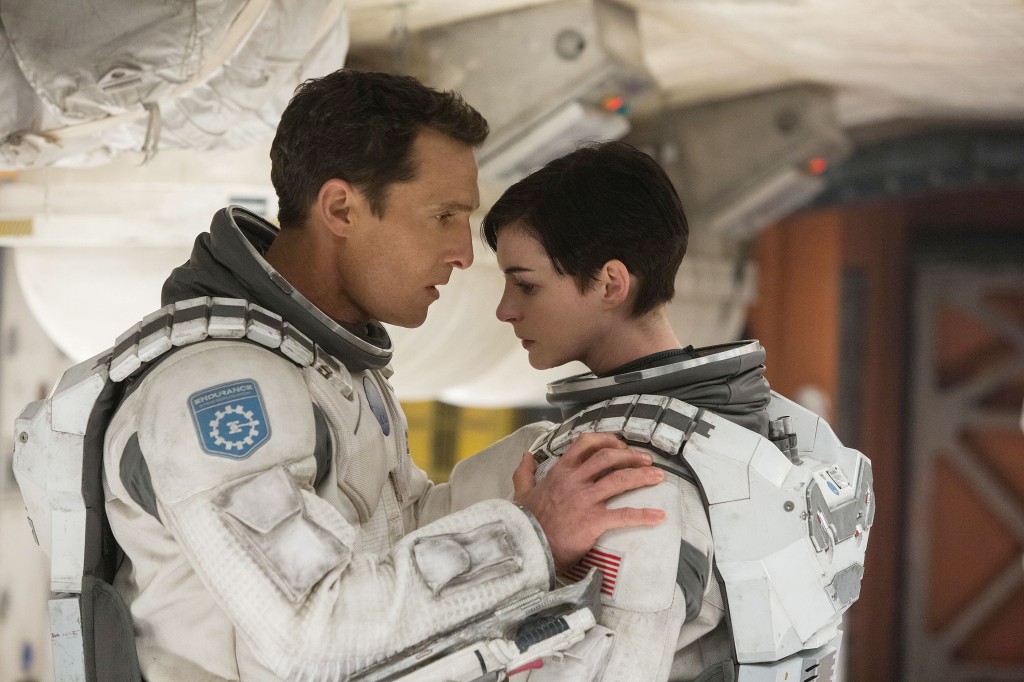
There’s a moment in Steven Spielberg’s 1977 film, “Close Encounters of the Third Kind,” where the main character, played by Richard Dreyfuss, leaves his family and goes in pursuit of an unknown force, probably caused by an alien.
In Christopher Nolan’s new film, “Interstellar,” the main character, Cooper, a farmer and former NASA test pilot played by Matthew McConaughey, also leaves his family and goes in pursuit of an unknown force, probably caused by an alien.
But while Dreyfuss’ character is cold to the family he abandons, the scenes between Cooper and his family are emotionally wrenching. Cooper frets about his son and daughter during his entire trip. Earth is dying, and Cooper goes to another solar system in search of a more hospitable home for mankind, with clues from an inscrutable alien force leading him toward a great unknown. The journey takes years, and being separated from his family takes its toll. It’s unexpected from a filmmaker known for more cerebral, technical stories (the movie was a Spielberg project before it got to Nolan), but the most powerful moments in “Interstellar” don’t come from the awe of seeing planets towering over a speck of a spaceship, but rather from the moments between Cooper and his daughter.
Watching a Nolan movie often feels like assembling a puzzle. More specifically, it feels like the part where you have the piece you think you need, but you’re not really sure where it’s supposed to go. And by the end, everything snaps into place. And then you stand back, and you realize that the puzzle was missing a few pieces and actually has some holes in it, but it still looks pretty cool so you buy the next puzzle from the manufacturer anyway, even if they never put all the pieces in the box.
The point is, Nolan’s plot dynamics have a satisfying whirr and click, but his characters’ emotional lives lack weight in most of his movies. Nolan has two major weaknesses: His characters serve his plots, instead of his plots serving his characters, and that dynamic masks the emotional shallowness of his movies. There’s a reason that no one batted an eye when Maggie Gyllenhaal replaced Katie Holmes between “Batman Begins” and “The Dark Knight.”
“Interstellar” attempts to address both of those issues. For once, his characters are central, and Nolan doesn’t need to cut through a thicket of plot to get to the emotional core of his film — he aims straight for the relationship between Cooper and his daughter, giving it emotional heft. But by doing that, Nolan only highlights his weaknesses.
Much ado has been made of “Interstellar’s” scientific accuracy. And for most of the movie, it is — as explained by the repetitive exposition. But in the last third of the film, physics are thrown out the spaceship window. Eddie Redmayne — er, Stephen Hawking — would weep. According to the scientists in the movie, metaphysics and actual physics follow a conflated set of principles. Love is a force in the physical universe.
In “Inception,” emotions also affect the laws of physics, but that’s in a dreamscape, where it’s alright for mental processes to affect physics. The conceit also recalls the “Harry Potter” series, where love holds immense magical power. But there, it’s explained by the laws of, well, magic.
In “Interstellar,” however, Nolan sets up the universe as Newton’s and Einstein’s, governed by non-magical, actual physics. The love-as-physics motif, then, comes off as unbelievable and hokey. The movie does what all space movies should do: It places humanity in the setting most inhospitable to it, pushing the species to its extreme, bringing its deepest emotions to the surface. Once they’re at the surface, it’s moving, but Nolan takes a few unnecessary detours to get there.
While the emotions-are-physics part of “Interstellar” is unconvincing, it’s still a technical piece of craftsmanship, genuinely thrilling, and with a majestic score by Hans Zimmer that attempts to invoke reverence for the cosmos. Like Alfonso Cuarón’s “Gravity” last year, it’s influenced by Stanley Kubrick’s 1968 film, “2001: A Space Odyssey,” as all space movies are, and smartly repurposes some scenes and imagery from it.
All of Christopher Nolan’s movies have one common theme: the conflict between the main character’s professional life and his personal one. In “Inception,” the main character’s memories of his wife interfere with his dreamscape heist work. In the Batman movies, well, it’s obvious. In every movie before “Interstellar,” Nolan has always approached it from the angle of the personal getting in the way of the professional. Here, it’s the other way around: The professional gets in the way of the personal. Cooper’s not an astronaut with a daughter, he’s a dad who’s been to space.


